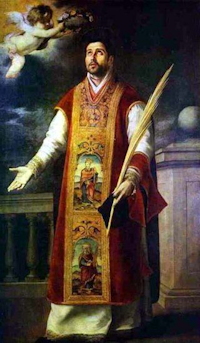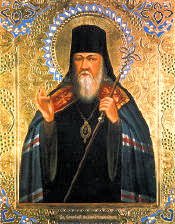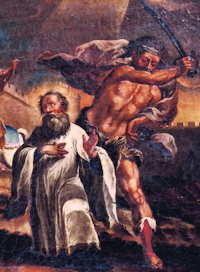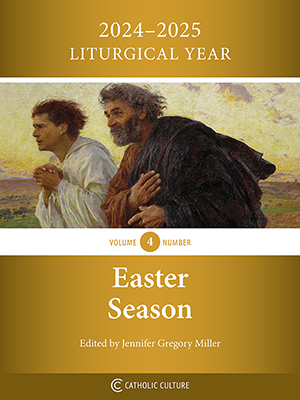Lent: March 11th
Tuesday of the First Week of Lent
Other Commemorations: St. Eulogius, Priest and Martyr (RM); St. Sophronius, Bishop (RM)
» Enjoy our Liturgical Seasons series of e-books!
The readings and propers of the Mass shows the Church's constant effort to acquaint us with the teaching of her Founder, and to strengthen us to follow and live his teachings. Mere formalism and externalism are of no value in the religion of Christ. God demands of his people a worship in spirit and in truth, and a conversion which comes from the heart.
Lent is a time set apart to seek the Lord. It is a special time of divine mercy and grace. The Church, acting as God's prophet, calls us to return to the Lord by true penance. The word of God which is sown so abundantly during Lent should grow and bear fruit in us if we have really prepared ourselves by fasting and discipline of the flesh. —St. Andrew Bible Missal
The Roman Martyrology today commemorates the martyred priest, St. Eulogius of Cordoba, Spain (d. 859), who was slain by the Moors. A noted scholar of Scripture, Eulogius was arrested in 850 after writing Exhortation of Martyrdom for two young virgin martyrs, Flora and Mary, who were beheaded after refusing to abjure the faith. Released after a time Eulogius was named archbishop of Cordoba or Toledo. Before he could be consecrated, he aided Leocritia, a young Moorish woman who had converted to Christianity. They were caught and beheaded. Eulogius also wrote The Memorial of the Saints and an Apologia.
St. Sophronius (d. 638) is also included in today's Roman Martyrology. He was a simple monk who pursued a life of prayer and sacrifice first in the desert of Egypt, then near the Jordan River, then finally in the Holy City of Jerusalem. He was ultimately chosen to be bishop and Patriarch of Jerusalem in the early 7th century. He valiantly defended the true and full humanity of Christ in the face of the heresy of Monothelitism, which denied that Jesus had a human as well as a divine will. The year before his death in 638, he witnessed the capture of Jerusalem by the Muslims under the Caliph Omar. Several of his sermons and poems have survived until this day. St. Sophronius is one of the Fathers of the Church.
Meditation for Tuesday of the First Week of Lent:
In the liturgical texts for today is hidden the mystery of the Mother of God, intimately connected with that of the incarnation of the Son of God. Let us look at the texts, and begin with the reading from the prophet Isaiah.
So shall my word be that goes forth from my mouth: it shall not return to me empty (55, 11)
When the prophet Isaiah made this affirmation, it was not at all to bring out something merely trivial, but rather a contradiction of what might be expected. For this passage belongs certainly to the story of the passion of Israel, where we read that God’s appeals to his people were continually defeated and that his word invariably remained fruitless, while God appears seated astride history, but not as a conqueror. For everything happened as a sign: the crossing of the Red Sea, the blossoming of the period of the Kings, the return of Israel to their country out of exile, all this now fades away. God’s seed in the world seems to give no results. The prophecy, therefore, however wrapped in obscurity, is an encouragement to all those who, in spite of everything continue to believe in the power of God, convince that the world is not just rocky soil in which the seed cannot find room to grow, but certain that the soil will not always be only a thin layer on the surface from which the birds day by day peck out suddenly what seed has there fallen upon it. (cf. Mk 4,1-9).
For us Christians an affirmation of this kind has the ring of the promised coming of Jesus Christ, thanks to which the word of God has now truly penetrated into the earth and has become bread for us all: seed which bears fruit through the ages, a fruitful response in which God’s discourse has taken root in this world in vital fashion. It is difficult to find elsewhere the mystery of Christ allied to that of Mary in a form as clear and condensed as in the perspective of this promise: for when it affirms that the word, or better the seed, bears fruit, it means to say that it does not fall on the ground to rebound like a ball, but that instead it penetrates deeply into the soil to absorb the moisture there and transform it into itself, truly producing something new, transubstantiating that same earth into fruit. The grain does not remain alone: this is part of the fertility mystery of the earth—Mary, the holy soil of the Church, as the Fathers fittingly call her, belongs to Christ. The mystery of Mary signifies in this connection that the word does not remain alone; rather it assumes the other, the earth, into itself; in the earth of the Mother the word becomes man, and now, mingled with the soil of the whole of humanity, it can return again to God.
The Gospel on the other hand seems to be speaking of something quite different. Here it is a question of our mode of prayer, its correct form, its proper content, the way to comport ourselves, and genuine recollection: not so much therefore of what it is for God to do, but of how we ought to act before him. In reality the two readings are interdependent; we might say that in the Gospel we come now to see how it is possible for human beings to become a fertile field for the word of God. This they can become by preparing those elements by which a life can grow and mature. They attain this end by themselves living from these elements, thus transforming themselves, being impregnated with the word, in the word, immersing their life in prayer and therefore in God.
So this Gospel, then, accords with the introduction to the Marian mystery given by Luke, when in more than one place he says of Mary that she ‘kept’ the word in her heart (2,19; 2,51). Mary united in herself the various currents in Israel; in her prayer she bore within herself the suffering and the greatness of that history, to convert it into a fertile land for the living God. To pray undoubtedly means much more, as the Gospel tells us, than speaking without reflection, merely mouthing words. To be a field for the word means to be earth which allows itself to be absorbed by the seed, which assimilates itself to the see, renouncing itself so as to make the seed germinate. With her motherhood Mary transfused into it her very substance, body and soul, so that a new life might come forth. The saying about the sword which would pierce her soul (Lk 2,35) has a much greater and more profound meaning: Mary makes herself completely available as the soil, she allows herself to be used and consumed so as to be transformed into him, who has need of us in order to become the fruit of the earth.
In the Collect for today we are called upon to have a longing desire for God. The Fathers of the Church maintain that to pray is nothing else than to turn into a longing desire for the Lord. In Mary this petition is heard: she is, may I say, a vessel of desire in whom life becomes prayer, and prayer life. St. John has wonderfully alluded to such a process of transformation while not calling Mary by name in his Gospel. He refers to her solely as the mother of Jesus. She in a certain sense set aside whatever in her life was personal, so as to be uniquely at the disposal of the Son; and it is precisely in this that Mary realised her personality.
I think that such links between the mystery of Christ and that of Mary put before us by today’s readings are of great importance for the Western activistic mentality, which has reached its peak in our age. For to our way of thinking the principle of domination alone still has value.: action, production, planning the world and, along with that, reconstructing it by ourselves, without owing anything to anybody but confidently relying on our own resources. With such a mentality, then, it is not by chance that we have more and more separated Christ from his mother, without taking account of how Mary as his mother, could signify something indispensable for theology and for faith. The whole of this way of considering the Church thus starts out from an erroneous way of thinking. We may even ourselves consider it as a technical product which we intend to programme cleverly and bring to realization with a tremendous expenditure of energy. We wonder whether that can happen which St. Louis-Marie Grignon de Montfort appended to a passage from the prophet Haggai “You have done much but nothing has come of it” (1,6). “If doing takes the upper hand, becoming autonomous, then those things which are not manufactured, but are living and need to mature, will no longer be able to exist.”
We want to get out of this one-sided outlook belonging to Western activism in order not to degrade the Church to a product of our doing and planning. The Church is not a finished artefact but always living from God, needing to develop and achieve maturity. For this she requires the Marian mystery, just as she herself is the mystery of Mary. She can train herself to that fecundity only if she submits to that sign; only then does she become holy soil for the word. We should adopt the symbol of the fertile soil, we should become people who hope, harvesting their own inner lives, persons who, deep within their prayer, their longing and their faith, make room for growth.
—Cardinal Joseph Ratzinger (Pope Benedict XVI), Journey Towards Easter

Tuesday of the First Week of Lent
Station with Sant'Anastasia al Palatino (St. Anastasia in the Palatine):
Today's stational church is St. Anastasia in Rome, where, formerly, the Mass of the Aurora on Christmas Day was celebrated. The first church was built in the late 3rd or early 4th century, and was one of the first parish churches of ancient Rome. It was given by a woman called Anastasia and called titulus Anastasiae after her. Later, it was dedicated to the early 4th century martyr St. Anastasia of Sirmium, who is included in the Roman Canon. Pope Francis granted the church to the Syro Malabar Church in July 2020.
For more on Sant'Anastasia al Palatino, see:
- Churches of Rome Info
- The Station Churches of Rome
- Rome Art Lover
- PNAC
- Aleteia
- Station Church
- The Catholic Traveler
For further information on the Station Churches, see The Stational Church.
St. Eulogius
 St. Eulogius was of a senatorian family of Cordova, at that time the capital of the Moors in Spain. Our Saint was educated among the clergy of the Church of St. Zoilus, a martyr who suffered with nineteen others under Diocletian. Here he distinguished himself, by his virtue and learning, and, being made priest, was placed at the head of the chief ecclesiastical school at Cordova. He joined assiduous watching, fasting, and prayer to his studies, and his humility, mildness, and charity gained him the affection and respect of every one.
St. Eulogius was of a senatorian family of Cordova, at that time the capital of the Moors in Spain. Our Saint was educated among the clergy of the Church of St. Zoilus, a martyr who suffered with nineteen others under Diocletian. Here he distinguished himself, by his virtue and learning, and, being made priest, was placed at the head of the chief ecclesiastical school at Cordova. He joined assiduous watching, fasting, and prayer to his studies, and his humility, mildness, and charity gained him the affection and respect of every one.
During the persecution raised against the Christians in the year 850, St. Eulogius was thrown into prison and there wrote his Exhortation to Martyrdom, addressed to the virgins Flora and Mary, who were beheaded the 24th of November, 851. Six days after their death Eulogius was set at liberty. In the year 852 several others suffered the like martyrdom. St. Eulogius encouraged all these martyrs to their triumphs, and was the support of that distressed flock.
The Archbishop of Toledo dying in 858. St. Eulogius was elected to succeed him; but there was some obstacle that hindered him from being consecrated, though he did not outlive his election two months.
A virgin, by name Leocritia, of a noble family among the Moors, had been instructed from her infancy in the Christian religion by one of her relatives, and privately baptized. Her father and mother used her very ill, and scourged her day and night to compel her to renounce the Faith. Having made her condition known to St. Eulogius and his sister Anulona, intimating that she desired to go where she might freely exercise her religion, they secretly procured her the means of getting away, and concealed her for some time among faithful friends.
But the matter was at length discovered, and they were all brought before the cadi, who threatened to have Eulogius scourged to death. The Saint told him that his torments would be of no avail, for he would never change his religion. Whereupon the cadi gave orders that he should be carried to the palace and be presented before the king's council. Eulogius began boldly to propose the truths of the Gospel to them. But, to prevent their hearing him, the council condemned him immediately to lose his head. As they were leading him to execution, one of the guards gave him a blow on the face, for having spoken against Mahomet; he turned the other cheek, and patiently received a second.
He received the stroke of death with great cheerfulness, on the 11th of March, 859. St. Leocritia was beheaded four days after him, and her body thrown into the river Guadalquivir, but taken out by the Christians.
—Excerpted from Lives of the Saints, by Alban Butler, Benziger Bros. ed. [1894]
Patronage: carpenters; coppersmiths
Highlights and Things to Do:
- Read more about St. Eulogius of Cordoba:
- Read He Chose to Die for Christ in Crisis Magazine.
- His relics are enshrined in the Oviedo Cathedral in Spain.
St. Sophronius
 Patriarch St. Sophronius of Jerusalem was called the Sophist because of his knowledge of Greek. He was an ardent opponent of monothelitism. Many of his writings, including the Florilegium and the Life of St. John the Almsgiver, are no longer extant. He wrote an encomium on John of Cyrus and composed 23 anacreontic odes on the feasts of the church. His Christmas homily of 634 suggests that the Saracens held Bethlehem at that time. (Historians had dated the event later). The Orthodox remember St. Sophronius chiefly as the author of the life of St. Mary of Egypt. Sophronius was born in Damascus around 560. He and his friend John Moschus became ascetics together while they were in their late teens or early twenties. Some say they lived near the Jordan; some say they lived in Egypt. In 605, Sophronius fled to Alexandria in the wake of Persian invaders, and when the Persians invaded Alexandria in 616, he fled to Rome. In 619, he returned to Palestine and lived in the Theodosius monastery in Jerusalem. When Patriarch Cyrus of Alexandria began to preach monothelitism, St. Sophronius traveled to that city to argue against him; in 633, when Patriarch Sergius of Constantinople began to preach monothelitism, St. Sophronius traveled to that city to argue against him. Neither visit was successful. After Sophronius was elected Patriarch of Jerusalem in 634, he wrote the Synodical Letter to teach the two wills of Christ. In 637, the Muslims captured Jerusalem; St. Sophronius died a year later of grief at the fall of his city.
Patriarch St. Sophronius of Jerusalem was called the Sophist because of his knowledge of Greek. He was an ardent opponent of monothelitism. Many of his writings, including the Florilegium and the Life of St. John the Almsgiver, are no longer extant. He wrote an encomium on John of Cyrus and composed 23 anacreontic odes on the feasts of the church. His Christmas homily of 634 suggests that the Saracens held Bethlehem at that time. (Historians had dated the event later). The Orthodox remember St. Sophronius chiefly as the author of the life of St. Mary of Egypt. Sophronius was born in Damascus around 560. He and his friend John Moschus became ascetics together while they were in their late teens or early twenties. Some say they lived near the Jordan; some say they lived in Egypt. In 605, Sophronius fled to Alexandria in the wake of Persian invaders, and when the Persians invaded Alexandria in 616, he fled to Rome. In 619, he returned to Palestine and lived in the Theodosius monastery in Jerusalem. When Patriarch Cyrus of Alexandria began to preach monothelitism, St. Sophronius traveled to that city to argue against him; in 633, when Patriarch Sergius of Constantinople began to preach monothelitism, St. Sophronius traveled to that city to argue against him. Neither visit was successful. After Sophronius was elected Patriarch of Jerusalem in 634, he wrote the Synodical Letter to teach the two wills of Christ. In 637, the Muslims captured Jerusalem; St. Sophronius died a year later of grief at the fall of his city.
Symbols and Representation: Vested as a bishop, with right hand upheld in blessing, holding a Gospel Book or scroll
Highlights and Things to Do:
- Read more about this Father of the Church:






